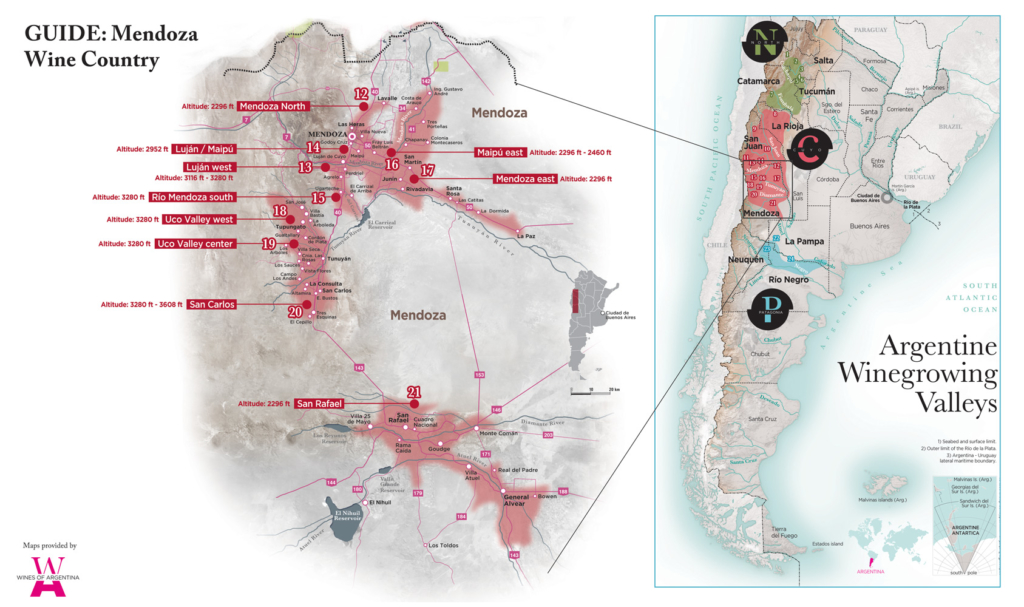Located at the base of the Andes Mountains (one of the world’s longest mountain ranges with peaks as high as 22,838 feet), the region of Mendoza is home to approximately 356,000 acres of stunning vineyards planted between 2,000 – 5,000 feet above sea level. The vineyards of Mendoza are some of the highest altitude vineyards in the world.

Wine World Ranking |
The Mendoza region produces anywhere from 2/3s to 3/4s of all of Argentina’s wine and is the fifth largest wine growing area in the world and the largest in Latin America. Mendoza includes four growing regions: |
|
Most Common Varietals |
The most common red varietals include: Malbec, Cabernet Sauvignon, Tempranillo, Shiraz and Bonarda. The white varietals include: Chardonnay, Sauvignon Blanc, and Torrontes (a white grape that is indigenious to Argentina). The highest rated Malbecs may be found in the high altitude regions of Lujan de Cuyo and the Uco Valley between 2,800 and 5,000 feet in elevation. |
|
Time of Year To Go |
Mendoza enjoys 300 days of sunshine every year, receiving only 8 inches of rain per year. The climate is semi-arid and while it has four distinct seasons, there typically are no extremes in temperature. The biggest weather risk is the summertime (the Northern hemisphere’s winter) hail known locally as La Piedra. September to March is the most popular time to visit Mendoza. We visited over New Years and the weather was sunny with highs in the 70s. The grape harvest begins in late January. The harvest festival, Vendimia, typically occurs in late February, early March and creates a hive of activity at the wineries and within the region’s villages. |
|
Getting to Mendoza |
After hearing amazing reports about Buenos Aires we opted to make a brief stop in this European-styled city prior to continuing on the Mendoza. We spent three wonderful days in BA (as the locals refer to it). However, if you enjoy village travel, like we do, we were ready to leave the city behind. BA has two airports, the international airport (which we flew into) and the city airport (for in-country flights). We flew from the city airport to Mendoza City (same name as the region which can be confusing). We picked up a rental car and had no difficulty finding our hotel as they had provided excellent directions. Another way to get to Mendoza is to fly into San Jose, Chile and then either drive over the Andes (approximately 5-1/2hrs) or fly from San Jose to Mendoza. To research your options check out the transportation planning site, Rome2Rio. |
|
Where to Stay |
I can’t say enough good things about Casa Glebinias, a garden hotel, located in the Luján de Cuyo region of Mendoza in the village of Chacras de Coria. The Aristarain family warmly welcomed us to the sanctuary they lovingly built after purchasing the property in 1982. Martin, the son of Maria and Alberto, runs this quaint property in which guests stay in individual casitas consisting of architectural elements hand-curated by Maria (an art historian). The family goes out of its way to provide warm and personalized hospitality, including the booking of wine tastings and ground transportation. They also provide a lovely breakfast and dinner at the main house. After a day of exploring and tasting it was very nice to return to Casa Glebinias where we could relax by the pool or in the magnificent gardens before returning to our own casita in Mendoza. |
|
Getting Around Mendoza |
Rather than driving I would recommend that you hire a driver (either before you leave or at your hotel) or join a small tour group for a tasting experience. A few suggestions may be found here. The roads are narrow and can be poorly marked. And besides, it’s no fun to have to sit out a tasting if you are the designated driver! |
|
Notable Places to Eat |
Mendoza has many outstanding restaurants. A list of the options in the area may be found at TripAdvisor or through OpenTable. The Argentine chef, Francis Mallman (Chef’s Table fame), has his restaurant, 1884, near Mendoza where he specializes in rustic Argentine food with hints of gaucho (Argentine cowboy) and European influences. |
|
Getting Inspired |
Watch “It Starts with Wine” Episode 2 on Amazon Prime highlighting Laura Catena, managing director of Bodega Catena Zapata and founder of the Catena Institute of Wine where research into Argentine terroir, particularly the element of altitude and the Malbec variety, has been integral in the modern profile of wines of Mendoza. To read more about Laura Catena check out this Bon Appetit article about her life and the wine and food of Mendoza. Want to see Francis Mallman talk about his open fire cooking method? Check out Season One of Chef’s Table on Netflix. Want to try to make empanadas before heading out? Check out this beef empanada recipe from Bon Appetit. |
|
Planning Resources |
For planning ideas refer to:
|
|
Things I Wished That I Had Known |
The wine region of Chile sits on the other side of the Andes Mountains from Mendoza. You could easily add three to four days to your itinerary to see the 9th largest wine region of the world. I did not realize how close Mendoza was to Chile and we missed the opportunity to take advantage of having already made the long flight to Argentina to also visit Chile. It was a very unfortunate oversight! |
|
Itineraries |
||
Related Stories |
Mary Beth I have a passion for creating and experiencing unforgettable moments and sharing those with others. I hope that this story has helped you experience one of those moments.